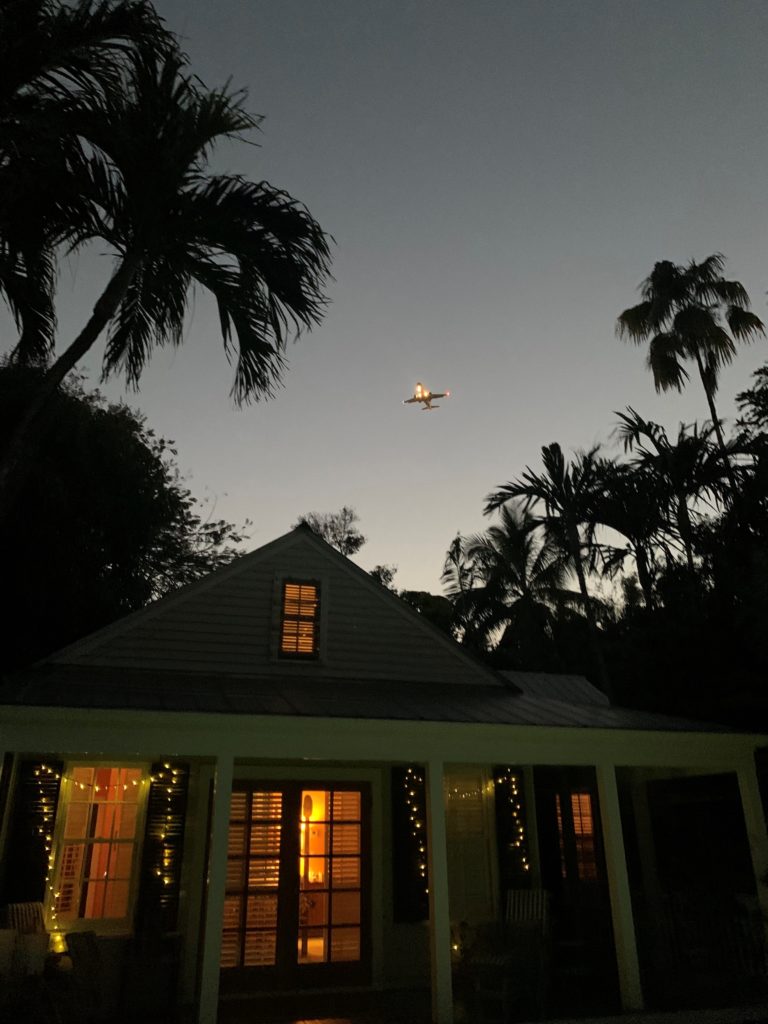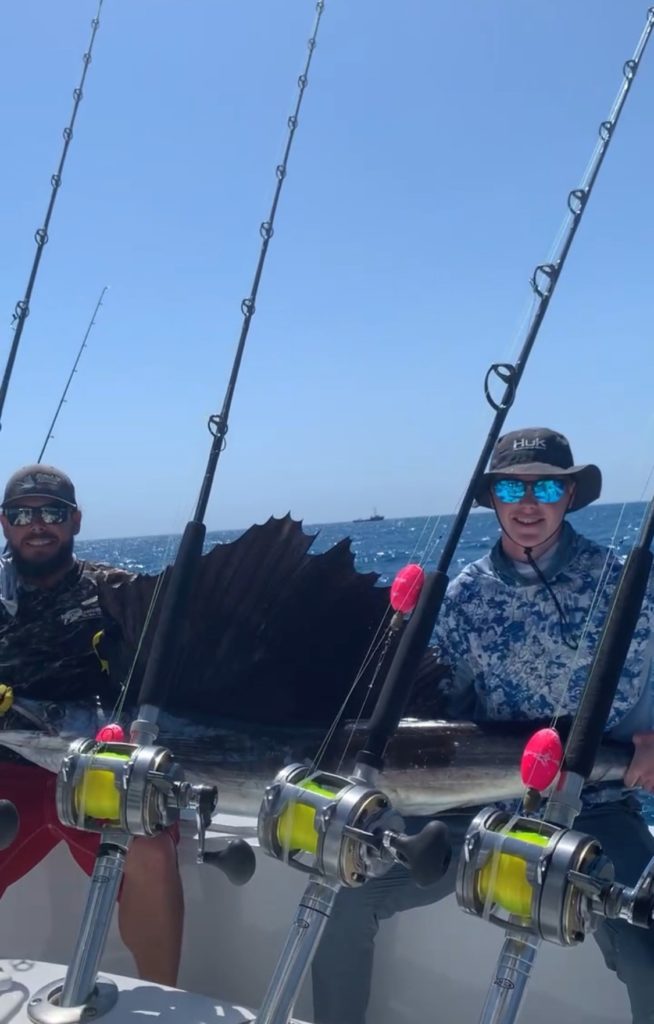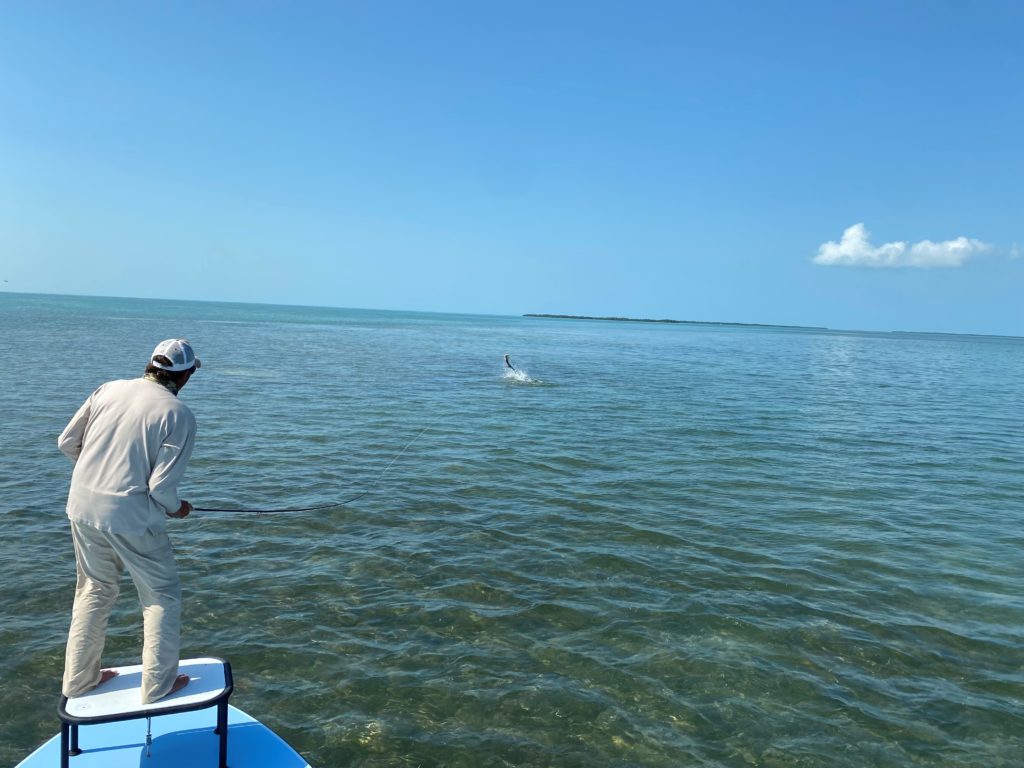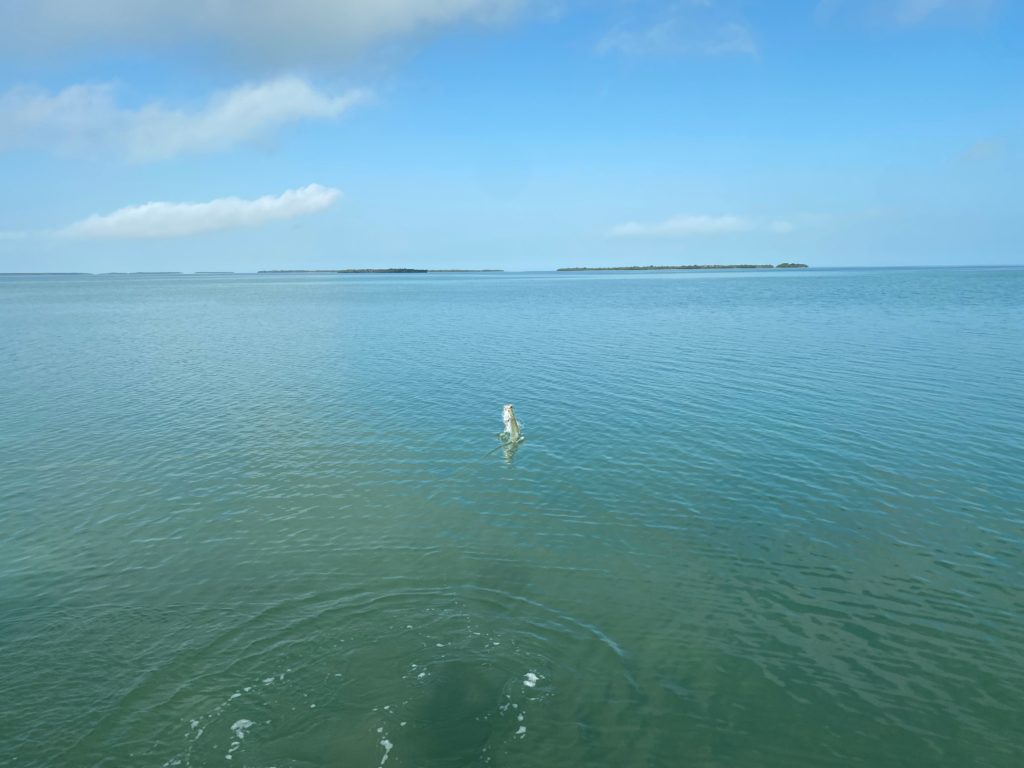Dear Survivor,
“Many go fishing all their lives without knowing that it is not fish they are after,” wrote Henry David Thoreau. But if it’s fish you’re after, then get yourself aboard the Double Down out of charter boat row in Key West and go fishing with captain Brice Barr and first mate Shawn. You can tell them Your Survival Guy sent you, and you can thank me later. I promise.
Aboard the Double Down is exactly where you could find us in mid-March at what I refer to as Summer Camp in Key West for our second trip in two years. We caught sailfish and an assortment of pelagic on both trips. But let’s get right down to this latest excursion where the sailfish weren’t taking our live herring skimming the surface kite fishing from outriggers.
We had eight live herring out—three on the port rigger, three on starboard, in long, middle, and short distances, and two from spinning rods directly off stern. Let me just put this out there; if there’s fish biting, captain Bryce will find them like nobody’s business. His helm station on the bridge gives him a bird’s eye view, but his ace in the hole is his network as he works the Coconut Telegraph with other captains. They’ve built years of trust, sharing the inside scoop on what’s biting. If they’re biting, captain Bryce knows where, when, and why.
At this point, the trip was on the quiet side—not to be confused with the constant work of setting baits and working lines—this is not a day at the beach. And in fact, you might be smart to do some leg squats before the trip because it’s an all-hands-on-deck affair. And then it happened.
Right about when Capt. was thinking about calling it a day, he noticed some birds working the surface and said to Shawn, “I’m seeing some spouting over there. Let’s bring in the baits.” Suddenly Capt. put the throttles down full, and cruised to the action. You could see the sailfish going crazy, moving through the water like bolts of electricity—the most beautiful blue coloring—like blue-spotted cheetahs zipping across the surface and pounding the baitfish.
We cast a live bait in front of them, waited for the strike, and then nothing. “They’re feasting on wahoo,” Bryce said. We were throwing herring. “It’s like if you’re eating a steak dinner, and you’re not ready for dessert yet. We’re throwing the dessert.” And then, just like that, as another dessert was served five feet in front of a darting sailfish, “Boom” fish on! The drag screamed like Steven Tyler of Aerosmith, and the dream was on.
TO BE CONTINUED…
GUNS AND MONEY: Ukraine Proves Every Home Should Stock Guns and Cash
With so many unknowns about Russia’s invasion of Ukraine, what is clear is that having an armed citizenry works in street-to-street combat. Before getting into the devastating potential for a Russian nuclear attack, let’s focus on self-defense.
Because it is pride for one’s home and country and the ability to fight back that makes self-defense work. This is not a sophisticated subject. Give your people the ability to defend themselves, and chances are they will.
Look at the food lines in Ukraine this Monday morning wrapped around buildings peacefully waiting for their turn. We’ve seen how crises like this can turn into a disaster of looting and violence. Not in Ukraine because there are consequences. It should be case study A for progressive DAs and mayors of big blue-state cities. Period.
In my reading of Nuclear Folly: A History of the Cuban Missile Crisis by Serhii Plokhy, what you realize is how lucky, yes lucky, we were to avoid a nuclear offensive by then Russian leader Nikita Khrushchev. One misstep or misunderstanding and we have an offensive strike by tactical nukes from Cuba, only 90 miles south of Key West.
“Today, every inhabitant of this planet must contemplate the day when this planet may no longer be habitable. Every man, woman, and child lives under a nuclear sword of Damocles, hanging by the slenderest of threads, capable of being cut at any moment by accident or miscalculation or by madness.” —JOHN F. KENNEDY, SEPTEMBER 1961
“Of course, I was scared. It would have been insane not to be scared, I was frightened about what could happen to my country and all the countries that would be devastated by a nuclear war. If being frightened meant that I helped avert such insanity, then I’m glad I was frightened. One of the problems in the world today is that not enough people are sufficiently frightened by danger of nuclear war.”— NIKITA KHRUSHCHEV, DECEMBER 1962
In reading The Gulag Archipelago, Volume 1, by Aleksandr Solzhenitsyn, you see how thin the line is between being the one serving 20-years in the gulag for no reason compared to being the one making up your crimes on the fly. How much has really changed in Russia? Are not everyday Russians constantly in fear of being bullied by Putin? The end of the USSR did nothing for a ground-up revolution by the people. Can it happen today?
As Your Survival Guy, you know I’m not in the prediction business, especially in times like these where talk is cheap. No, when we’re talking about your life’s savings we’re dealing with deadly serious business. In a matter of days, you see what happens to predictions that are wrong. Predictions that we’re banking on a Fed rate increase in March that looks less likely to be as aggressive as originally thought.
If you have the right investment plan heading into a crisis, then you can live with the phrase “don’t just do something, stand there.” And let’s not forget how our own politicians are working against us, with John Kerry for example talking about global warming while Europe freezes. And how about the leaders in these countries making their populace dependent on a tyrant for heat and hot water. Hello?
Get your guns and your training now and do what you can to harden your family’s self defense.
RUSSIA FALLOUT: Demand for Bunkers Rises 6900%
Since Russia invaded Ukraine, sparking the first war in Europe in decades, everyone in the developed world has begun to rethink the risks in their lives. Many people are taking action to secure their family’s future. Some are even buying bomb shelters. Demand for bomb shelters has gone up, according to one manufacturer, Rising S Company, by 6900% since the invasion. VICE reports:
For the first time in five years, Gary Lynch’s company is so busy that he needed to leave his office to go help his employees in the field.
His company sells steel bunkers and bomb shelters.
The general manager of the Texas-based Rising S Company had to help install a 1,600-square-foot model, which goes for a touch over $300,000. He told VICE News during his lunch break at the local Taco Bell that his company received over 700 inquiries recently, in a time frame where they typically would have received about 10.
“On Thursday morning, when we started seeing the nuclear threats, the phones started ringing immediately,” said Lynch. Some of the people who called were people who were already considering the need for a backyard bunker, and the Ukraine conflict is what finally pushed them over the edge. A good chunk of the inquiries, Lynch said, were pretty frantic.
“There’s the people who don’t know (what to ask); they’ve never looked at (bomb shelters) before,” said Lynch. “They’re the ones that are calling and asking, ‘Will this protect me from nuclear fallout?’, and we have to tell them ‘Well, no, it’s not going to protect you from that, from a direct hit from a bomb.’”
The threat of the Russian invasion of Ukraine becoming a conflict between the world’s two biggest military superpowers has many people thinking about what has felt unthinkable for a generation: a nuclear war. And for some who are frantically searching to ground themselves in uncertain times, they’re turning to something most people wouldn’t normally describe as “calming”—doomsday prepping.
Europeans are stocking up on iodine tablets (a Google Trends search shows near-vertical growth on that term in late February), and YouTube is suddenly full of “experts” giving advice on how to prepare for the end of the world. Those in the “doomsday prepper” community say their community has been growing for years, with climate change, a global pandemic, and the general “end times” vibe of the last several years. But it has accelerated in the past weeks.
John Ramey, the founder of the prepper website The Prepared and a former Obama White House adviser, said the community has doubled in the last few years and pointed to a pre-pandemic FEMA study that showed the number of American citizens preparing for some sort of disaster increased from 3.8 percent in 2017 to 5.2 percent in 2019.
Ramey said most of the folks who’ve been in the community for a long time aren’t the ones worked up. Neither Ramey nor Lynch said he thought nuclear war was imminent, but they’ve both been taking calls from people worried about it.
“The top search terms on our site have been war and nuclear-oriented things like iodine, nuclear, and even EMP,” said Ramey, referring to electrical magnetic pulse, which happens after a nuclear detonation. “So it’s clear that this is on people’s minds and that there’s a group, a portion of people, that are riled up, and concerned about it.”
Since Russian dictator Vladimir Putin launched a full-scale invasion of Ukraine last week and put his nuclear deterrent forces on “high alert”, the subreddit r/preppers has been inundated with “Questions from New Preppers.” On Facebook, people are reaching out to groups like “Prepping for Beginners” or “Doomsday Preppers Worldwide” with questions about what food to stock up on, how to make sure they have a supply of drinking water, and so on.
It’s never too late to start, but remember that you can’t save the world in a weekend. Focus on what you can do.
MARIUPOL OUT OF WATER: Could Your Family Last Five Days?
You have surely witnessed on the news and the internet the disastrous and sad scenes coming out of the war in Ukraine. Residents of cities where the fighting is hottest, like Mariupol, are being cut off from the conveniences of modern civilization, water, electricity, sewage and trash removal, food supplies, and heat. BBC reports:
Residents of the Ukrainian port city of Mariupol have told the BBC they are trying to survive a relentless barrage of Russian shelling that has smashed residential districts and cut off power and water supplies.
“There has been no light, no heat, and no water now for two full days and we have hardly any food left,” said Maxim, 27, an IT developer who was hiding in his grandparents’ apartment on Thursday morning.
“Food and medicine is not moving in Mariupol now. The local government tried to give out bread and water but it is gone,” he said. “I filled the bath with water before the water stopped. We have about five litres left.”
Maxim left his apartment after the Russian invasion began last week to be with his grandparents, who are in their eighties and cannot leave their sixth-floor, city-centre apartment. The three of them are sheltering with their pets in the hallway of the apartment, with no heating in the depth of winter, hiding from a barrage of shelling.
How long can the Ukrainians last under such conditions, in the freezing winter temperatures? How long could your family last without the basic conveniences of a modern life? Do you have food and water stored? Alternative sources of electricity and heat? How about a plan for sewage and waste removal if there’s no running water or trash pickup? If you don’t have a plan for each of these scenarios, you’ll be trying to come up with a plan after the fact.
Start making a plan today. The most important part of any emergency plan is water. You can’t survive a long time without it. Start small. Store just five days of water for your entire family. Don’t be surprised when that’s more water than you think. At a minimum, you want to have at least one gallon per day per person to be able to survive in relative comfort. A gallon will provide two quarts for drinking and two for light sanitation and cooking. Once you’ve done that, you’re ready to get serious. For a serious look at emergency water storage, click here to download my free special report, Emergency Water Storage: How Much, Containers, Purification & More. But only if you’re serious.
Where Can You Survive a Nuclear Attack in America?
Let’s just start this off with the caveat that given a full-scale nuclear war on earth, there will probably be nowhere you can live for very long. But there are some places where you stand a better chance of surviving the initial attack, according to Realtor.com’s data team. Lance Lambert writes for Realtor.com:
America’s top cities are not terrific places to be during a nuclear attack—many of them are likely to be on the first-strike target list, especially hubs for government, finance, or corporate infrastructure, or cities that just may be internationally famous (for symbolic value). Military bases are also a great big bullseye. But hold on: The federal government also considers things like airfields, ports, refineries, and energy centers to be targets.
“There is no safe place. There are only safer places,” says Robert Vicino, CEO and founder of the Vivos Group, a group that sells bunkers throughout the world.
You may want to head to Kansas City, MO. The metro has one of the highest rates of housing listings with bunkers or fallout shelters. It also has more than its fair share of homes with basements, as well as those made out of brick—a structure that is better prepared for a nuclear blast. The metro has become something of a prepper mecca—In 2013, Vivos announced plans to build a huge bunker capable of housing around 5,000 people. Structural issues caused the group to abandon the project a year later, but there’s still no shortage of large underground shelters.
On the downside, Fort Leavenworth, an army base on more than 5,000 acres, is about 35 miles to the northwest. So stick to the southeast side of the city.
If you survive the initial blast, you’ll face a long road ahead. One of the basic needs is drinking water, so living in a city like Duluth (No. 7) is a big plus, given the high number of properties with lakes, ponds, and wells. You’ll also need some form of power—San Luis Obispo has a higher-than-average number of homes with solar panels listed on realtor.com. And a city like Manchester has plenty of health care professionals to treat any festering injuries. (And there are likely to be plenty.)
If you’re worried about a nuclear event, what type of home should you seek out?
“Some [preppers] are all about water sources. Others want to get deep into the mountains,” says Theresa Mondale, broker and owner of the United Country-Western Montana Group in Missoula, MT. Mondale specializes in survivable and sustainable properties. “My clients range from college students, retired government officials to high-ranking Silicon Valley [folks].”
After Kansas City, the best places to survive nuclear disaster are New Haven, CT, in second place, followed by Ann Arbor, MI; Hagerstown, MD; Springfield, MA; Manchester, NH; Duluth, MN; San Luis Obispo, CA; Crestview, FL; and Lincoln, NE.
OK, so what are the place to avoid like nuclear waste? Let’s take a (scary) look.
Worst cities to survive a nuclear apocalypse
People around the world hunger for a taste of the Big Apple, but if a nuke drops while you visit, it could be your last taste: New York leads the list of worst places in the United States to ride out an attack. Like most of America’s largest cities, NYC would be hit with a deadly double whammy: In addition to being a primary target, it has precious few natural resources to make post-blast survival possible. Unless you enjoy eating grilled subway rats?
Big cities usually have most of their goods (food, bottled water, medical supplies) shipped in. Once that stopped, panic would quickly set in.
Even getting out of most urban areas, which rely on public transportation and are known for clogged roadways, could be near-impossible. That’s especially true for Miami, our fifth worst-ranked metro—as thousands of people learned while fleeing Hurricane Irma in September.
“There are very few ways to get out of here during a massive evacuation—the only way to go is north,” Duarte says. “Surprisingly, there are only three major highways out of South Florida. Under normal circumstances, those arteries are already congested.”
After New York, our data crunching ranked Los Angeles as the second-worst nuclear haven, Dallas the third, and Nashville, TN, the fourth.
Rounding out the list are Atlanta, ranked sixth, followed by Washington, DC; Philadelphia; Fayetteville, NC; and Seattle.
If you call one of these urban centers home, here’s something to cheer you up: Just about everyone would be screwed during a nuclear strike. So there’s that.
“If it does happen, I don’t know if any amount of time preparing will do much difference. I’ve seen what happens in the aftermath of a simple weather event—people go into chaos,” Duarte says. “That thing we call civilization goes away quick.”
If you’re looking for a better America, start your search with my Super States. This year’s #1 state is New Hampshire. If you’re serious about moving your family and business to a state where you are treated with respect, there’s no better time than now.
Survive and Thrive this Month.
Warm regards,
E.J.,
“Your Survival Guy”
- If someone forwarded this to you, and you want to learn more about Your Survival Guy, read about me here.
- If you would like to contact me and receive a response, please email me at ejsmith@yoursurvivalguy.com.
- Would you like to receive an email alert letting you know when Survive and Thrive is published each month? You can subscribe to my free email here.
- You can also follow me on Gab, MeWe, and Gettr.
P.S. OK, Your Survival Guy just got back from a Key West summer camp in March, and it was awesome. Look, it’s been a crazy couple of years for all of us with this Covid debacle, and we all need to step back and ask, “what the heck just happened?” We all need a break. I hope you’re with me. But vacations can be a tricky thing, especially if you’re not the only one taking one or have a full schedule. It’s why one day during our trip, I referred to it as summer camp.
But first, my idea of a perfect Key West day starts by getting up without an alarm. That’s followed by walking barefoot to the kitchen for a cup of joe, reading the headlines, then shuffling down to Date and Thyme for a coconut latte and a breakfast wrap. Then do nothing until noon-thirty, before heading to the Thirsty Mermaid for stone crab claws, oysters, and beer or Louie’s Backyard for a bloody and a smash burger. Follow that with an afternoon siesta, a swim, get ready for dinner, and be sipping a cocktail by six at Antonia’s.
Now, my idea of summer camp is still pretty good, but I’m not sure better than a perfect KW day. Because with summer camp, Your Survival Guy is up at 6 am, on the water by 7:00 or 7:30 am, fishing well into the afternoon, and almost too exhausted for dinner (That’s almost. Trust me, I’m never late to dinner.) or play 18-holes and take casting lessons at 4 pm. Hey, it’s a lot, but someone’s gotta do it. I hope it’s you.
We all need a vacation, especially right now. The toll from this medical tyranny is weighing on you. I get it. It’s time to clear your head, rub your eyes, shake it off and get moving to your happy place. It takes some planning, but you have to do it. We’re not getting any younger. Not only will your grandkids be a year older this time next year, but so will you.
With that said, you’re not going to be alone. Literally. Folks are moving about the country. Maybe figure out a place where you can jump around to if the crowds are too crazy at one particular harbor.
Action Line: Yes, you want to spend time with family. But you can’t forget about you. You need time to take care of yourself. Your family will thank you. Let’s do this. I’m here to help. Stick with Your Survival Guy here. And if you want to talk, you know how to reach me.
Deep Sea Fishing on the Double Down with Captain Barr and Shawn.
Early morning heading out for some fly fishing with Captain Erickson.
After a long day at summer camp in March.

P.P.S. When we arrived at the Stock Island marina, just north of Key West, we were anxious. Like the feeling you get when you’re driving to a ski mountain. You’re excited. You’re listening to music. Talking. Then, out of nowhere, you see the steep slopes, the crowds, and you get that feeling in your stomach where it’s too late to turn around.
A week earlier, I called Captain Ryan Erickson (referred to me by a client) and asked if he would take us fishing. “Yeah,” he said. “You’re timing is good. Just got in town from my season guiding in Colombia. I’ll have the boat set up by Thursday. See you 8 am.”
“Great, see you then,” I said. “What should we bring?”
“Polarized sunglasses and whatever you want to eat or drink. I’ll have water,” he said.
The day before our trip, I got a text from him that read, “Want to get out by 7 am tomorrow. See you then.”
“OK,” I replied.
“Better get our lunch for tomorrow,” I thought to myself and headed to Cole’s Peace Bakery on Eaton Street for three Cuban mixes and some more waters. About those frosty beverages. Let’s get something clear. This is a fishing trip, not a booze cruise. There’re plenty of those in front of Schooner Wharf that I highly recommend, especially the sunset ones. This is a fishing trip. Not a cruise.
Our Uber arrived at 6:30 am. We met Ryan at his corner slip, and then it hit me. Dressed in shorts, we probably looked as green as if we had just exited a ski rental building dressed in jeans. “Sunscreen is useless on the flats,” he reminded me later. This might be a long day. Flip flops removed, we climbed down into his skiff, he sprayed our feet to keep the boat clean, not necessarily about our feet. It’s about the boat.
Before we go any further in this fishing story, let’s get one thing clear. When you’re fishing with a guide, he’s in charge. Not you. It’s not your boat. It’s his boat. Also, I can’t guarantee you’ll become friends. Don’t ever forget that this is about fishing, not cruising. The reason guides guide is because they love to fish. Every guide or charter boat captain I’ve fished with is passionate about fishing, so try not to screw up their day on the water. This isn’t a fishing lesson. It’s the pinnacle of the sport.
As we cruised to the flats, we rounded into the shallows, and Ryan killed the engine. He positioned himself on the stern platform with a 20-foot carbon fiber pole and began poling us through three or five feet of water. He did that for eight hours, mind you. “You guys hunt?” he asked.
“No,” I said.
“This is like hunting,” he said (“Great,” I thought to myself). “You’re looking for fish, in this case permit, tailing as they nose around for crabs, maybe 100-yards off the bow. I’ll tell you the location, 10 O’clock or 1 O’clock. When you see the fish, point your pole to it and wait for my instructions to cast. Got it?”
“Yes,” I said.
Standing on the bow platform a couple feet in the air, smaller than a batter’s box, I felt like I was back in Little League awaiting instructions from the coach, trying to remember the signs given from third base. “What if I hook onto a fish and forget I’m on a platform,” I thought to myself. And then out of nowhere, Ryan said, “1 O’clock, 100-yards out. Do you see it?”
“No,” I said. Squinting hard.
“It’s coming at us,” he said. I still couldn’t see it. And then it was gone.
We did that for a few hours, jumping from spot to spot, flying around in a 15-foot flats skiff with a 70-hp Yamaha. Occasionally we saw Navy jets training off in the distance or a military helicopter flying over us. It was pretty cool, especially floating around eating our sandwiches with just a few puffy clouds in the sky.
“I wore a Trump hat all last season,” he said, in between bites.
I knew I had found a friend.
We fished some more, and as we were ending our day, we came across a tarpon floating just off a flat and casted at him—a perfect cast to give him a look he didn’t take, but the excitement of it is why you fish. And just like that, our eight-hour trip was over.
Until next time.
I want you to get out there. Don’t just stand there, do something. This isn’t investing. It’s fishing.
Fishing with Ryan a few days afterward, here’s my client hooking on to a tarpon.
P.P.P.S. In my conversations with you, you’re asking, “Hey, Survival Guy, why are bond prices down? Aren’t they supposed to be our anchor to windward?”
“Of course, they are,” I say, “but bond prices decline as interest rates rise.”
“Well, don’t take this the wrong way Survival Guy, but isn’t it obvious rates are going higher?” you say.
“About as obvious as predicting Covid or the war in Ukraine,” I respond.
Look, I’m Your Survival Guy, not Your Hope and a Prayer Guy. I know how ugly stock and bond markets can get, and I don’t get too worked up about temporary declines in prices. Your Survival Guy hasn’t sold his bonds. Your Survival Guy hasn’t sold his stocks. He always keeps a balanced portfolio and personally, just invested more in the market this week.
Your key in times like these is to understand why you do what you do. For me, I get a ton of peace of mind knowing that the importance of the Survival Guy Capital Structure pyramid hasn’t changed one bit. I know, I know, bonds are boring, blah, blah, blah. But you know what? When the you-know-what really hits the fan, bondholders get paid well before common shareholders. I like that. And if you’re in or near retirement, getting a return of principal matters a whole lot more than your return on it.
Don’t hate Your Survival Guy for this low interest rate environment and inflated assets. This is a formula for DISASTER constructed by economists at the Federal Reserve—a political beast if I’ve ever seen one. With that in mind, understand that bond price sensitivity, or duration, is a function of maturity and interest rates. The longer the maturity, the more sensitive prices are to interest rates (up and down).
Take a look at this table from the Federal Reserve below. Your Survival Guy sees the sweet spot around 3-years. That’s where I do my business today, and I’d suggest the same for you. Sure, there are values further out on the curve that are ripe for the picking. In the meantime, don’t be pushed out of your bonds. No one said this was going to be easy.
| Instruments | 2022 | 2022 | 2022 | 2022 | 2022 |
| Mar | Mar | Mar | Mar | Mar | |
| 15 | 16 | 17 | 18 | 21 | |
| Federal funds (effective) | 0.08 | 0.08 | 0.33 | 0.33 | 0.33 |
| Commercial Paper | |||||
| Nonfinancial | |||||
| 1-month | n.a. | 0.36 | 0.35 | 0.36 | 0.34 |
| 2-month | n.a. | n.a. | 0.62 | 0.65 | n.a. |
| 3-month | n.a. | n.a. | n.a. | n.a. | n.a. |
| Financial | |||||
| 1-month | 0.44 | n.a. | 0.59 | 0.46 | 0.49 |
| 2-month | n.a. | n.a. | n.a. | 0.63 | n.a. |
| 3-month | 0.91 | 0.90 | 1.01 | 0.80 | 0.79 |
| Bank prime loan | 3.25 | 3.25 | 3.50 | 3.50 | 3.50 |
| Discount window primary credit | 0.25 | 0.25 | 0.50 | 0.50 | 0.50 |
| U.S. government securities | |||||
| Treasury bills (secondary market) | |||||
| 4-week | 0.21 | 0.23 | 0.20 | 0.19 | 0.21 |
| 3-month | 0.46 | 0.43 | 0.40 | 0.41 | 0.55 |
| 6-month | 0.84 | 0.84 | 0.79 | 0.80 | 0.93 |
| 1-year | 1.19 | 1.26 | 1.20 | 1.19 | 1.28 |
| Treasury constant maturities | |||||
| Nominal | |||||
| 1-month | 0.22 | 0.24 | 0.20 | 0.19 | 0.22 |
| 3-month | 0.46 | 0.44 | 0.40 | 0.42 | 0.54 |
| 6-month | 0.86 | 0.86 | 0.81 | 0.83 | 0.95 |
| 1-year | 1.28 | 1.35 | 1.30 | 1.29 | 1.40 |
| 2-year | 1.85 | 1.95 | 1.94 | 1.97 | 2.14 |
| 3-year | 2.04 | 2.14 | 2.14 | 2.15 | 2.34 |
| 5-year | 2.10 | 2.18 | 2.17 | 2.14 | 2.33 |
| 7-year | 2.16 | 2.22 | 2.22 | 2.17 | 2.36 |
| 10-year | 2.15 | 2.19 | 2.20 | 2.14 | 2.32 |
| 20-year | 2.57 | 2.56 | 2.60 | 2.53 | 2.67 |
| 30-year | 2.49 | 2.46 | 2.50 | 2.42 | 2.55 |
| Inflation indexed | |||||
| 5-year | -1.32 | -1.16 | -1.34 | -1.34 | -1.19 |
| 7-year | -0.98 | -0.86 | -1.00 | -1.00 | -0.86 |
| 10-year | -0.69 | -0.61 | -0.71 | -0.72 | -0.58 |
| 20-year | -0.25 | -0.22 | -0.29 | -0.30 | -0.19 |
| 30-year | -0.03 | -0.02 | -0.08 | -0.09 | 0.01 |
| Inflation-indexed long-term average | -0.09 | -0.07 | -0.13 | -0.14 | -0.03 |
I want all the success in the world for you. You know being successful isn’t easy. It requires discipline and getting up early–not the one-two punch most think about in retirement. That’s OK. That’s my job. Stick with Your Survival Guy here. And if you want to talk, you know how to reach me.
Download this post as a PDF by clicking here.










